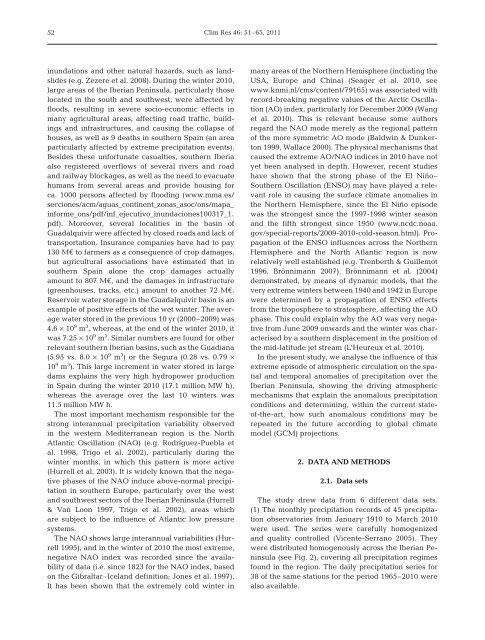Extreme winter precipitation in the Iberian Peninsula in 2010 ...
Extreme winter precipitation in the Iberian Peninsula in 2010 ...
Extreme winter precipitation in the Iberian Peninsula in 2010 ...
You also want an ePaper? Increase the reach of your titles
YUMPU automatically turns print PDFs into web optimized ePapers that Google loves.
52<br />
Clim Res 46: 51–65, 2011<br />
<strong>in</strong>undations and o<strong>the</strong>r natural hazards, such as landslides<br />
(e.g. Zezere et al. 2008). Dur<strong>in</strong>g <strong>the</strong> <strong>w<strong>in</strong>ter</strong> <strong>2010</strong>,<br />
large areas of <strong>the</strong> <strong>Iberian</strong> Pen<strong>in</strong>sula, particularly those<br />
located <strong>in</strong> <strong>the</strong> south and southwest, were affected by<br />
floods, result<strong>in</strong>g <strong>in</strong> severe socio-economic effects <strong>in</strong><br />
many agricultural areas, affect<strong>in</strong>g road traffic, build<strong>in</strong>gs<br />
and <strong>in</strong>frastructures, and caus<strong>in</strong>g <strong>the</strong> collapse of<br />
houses, as well as 9 deaths <strong>in</strong> sou<strong>the</strong>rn Spa<strong>in</strong> (an area<br />
particularly affected by extreme <strong>precipitation</strong> events).<br />
Besides <strong>the</strong>se unfortunate casualties, sou<strong>the</strong>rn Iberia<br />
also registered overflows of several rivers and road<br />
and railway blockages, as well as <strong>the</strong> need to evacuate<br />
humans from several areas and provide hous<strong>in</strong>g for<br />
ca. 1000 persons affected by flood<strong>in</strong>g (www.mma.es/<br />
secciones/acm/aguas_cont<strong>in</strong>ent_zonas_asoc/ons/mapa_<br />
<strong>in</strong>forme_ons/pdf/<strong>in</strong>f_ejecutivo_<strong>in</strong>undaciones100317_1.<br />
pdf). Moreover, several localities <strong>in</strong> <strong>the</strong> bas<strong>in</strong> of<br />
Guadalquivir were affected by closed roads and lack of<br />
transportation. Insurance companies have had to pay<br />
130 M€ to farmers as a consequence of crop damages,<br />
but agricultural associations have estimated that <strong>in</strong><br />
sou<strong>the</strong>rn Spa<strong>in</strong> alone <strong>the</strong> crop damages actually<br />
amount to 807 M€, and <strong>the</strong> damages <strong>in</strong> <strong>in</strong>frastructure<br />
(greenhouses, tracks, etc.) amount to ano<strong>the</strong>r 72 M€.<br />
Reservoir water storage <strong>in</strong> <strong>the</strong> Guadalquivir bas<strong>in</strong> is an<br />
example of positive effects of <strong>the</strong> wet <strong>w<strong>in</strong>ter</strong>. The average<br />
water stored <strong>in</strong> <strong>the</strong> previous 10 yr (2000–2009) was<br />
4.6 × 10 9 m 3 , whereas, at <strong>the</strong> end of <strong>the</strong> <strong>w<strong>in</strong>ter</strong> <strong>2010</strong>, it<br />
was 7.25 × 10 9 m 3 . Similar numbers are found for o<strong>the</strong>r<br />
relevant sou<strong>the</strong>rn <strong>Iberian</strong> bas<strong>in</strong>s, such as <strong>the</strong> Guadiana<br />
(5.95 vs. 8.0 × 10 9 m 3 ) or <strong>the</strong> Segura (0.28 vs. 0.79 ×<br />
10 9 m 3 ). This large <strong>in</strong>crement <strong>in</strong> water stored <strong>in</strong> large<br />
dams expla<strong>in</strong>s <strong>the</strong> very high hydropower production<br />
<strong>in</strong> Spa<strong>in</strong> dur<strong>in</strong>g <strong>the</strong> <strong>w<strong>in</strong>ter</strong> <strong>2010</strong> (17.1 million MW h),<br />
whereas <strong>the</strong> average over <strong>the</strong> last 10 <strong>w<strong>in</strong>ter</strong>s was<br />
11.5 million MW h.<br />
The most important mechanism responsible for <strong>the</strong><br />
strong <strong>in</strong>terannual <strong>precipitation</strong> variability observed<br />
<strong>in</strong> <strong>the</strong> western Mediterranean region is <strong>the</strong> North<br />
Atlantic Oscillation (NAO) (e.g. Rodríguez-Puebla et<br />
al. 1998, Trigo et al. 2002), particularly dur<strong>in</strong>g <strong>the</strong><br />
<strong>w<strong>in</strong>ter</strong> months, <strong>in</strong> which this pattern is more active<br />
(Hurrell et al. 2003). It is widely known that <strong>the</strong> negative<br />
phases of <strong>the</strong> NAO <strong>in</strong>duce above-normal <strong>precipitation</strong><br />
<strong>in</strong> sou<strong>the</strong>rn Europe, particularly over <strong>the</strong> west<br />
and southwest sectors of <strong>the</strong> <strong>Iberian</strong> Pen<strong>in</strong>sula (Hurrell<br />
& Van Loon 1997, Trigo et al. 2002), areas which<br />
are subject to <strong>the</strong> <strong>in</strong>fluence of Atlantic low pressure<br />
systems.<br />
The NAO shows large <strong>in</strong>terannual variabilities (Hurrell<br />
1995), and <strong>in</strong> <strong>the</strong> <strong>w<strong>in</strong>ter</strong> of <strong>2010</strong> <strong>the</strong> most extreme,<br />
negative NAO <strong>in</strong>dex was recorded s<strong>in</strong>ce <strong>the</strong> availability<br />
of data (i.e. s<strong>in</strong>ce 1823 for <strong>the</strong> NAO <strong>in</strong>dex, based<br />
on <strong>the</strong> Gibraltar–Iceland def<strong>in</strong>ition; Jones et al. 1997).<br />
It has been shown that <strong>the</strong> extremely cold <strong>w<strong>in</strong>ter</strong> <strong>in</strong><br />
many areas of <strong>the</strong> Nor<strong>the</strong>rn Hemisphere (<strong>in</strong>clud<strong>in</strong>g <strong>the</strong><br />
USA, Europe and Ch<strong>in</strong>a) (Seager et al. <strong>2010</strong>, see<br />
www.knmi.nl/cms/content/79165) was associated with<br />
record-break<strong>in</strong>g negative values of <strong>the</strong> Arctic Oscillation<br />
(AO) <strong>in</strong>dex, particularly for December 2009 (Wang<br />
et al. <strong>2010</strong>). This is relevant because some authors<br />
regard <strong>the</strong> NAO mode merely as <strong>the</strong> regional pattern<br />
of <strong>the</strong> more symmetric AO mode (Baldw<strong>in</strong> & Dunkerton<br />
1999, Wallace 2000). The physical mechanisms that<br />
caused <strong>the</strong> extreme AO/NAO <strong>in</strong>dices <strong>in</strong> <strong>2010</strong> have not<br />
yet been analysed <strong>in</strong> depth. However, recent studies<br />
have shown that <strong>the</strong> strong phase of <strong>the</strong> El Niño–<br />
Sou<strong>the</strong>rn Oscillation (ENSO) may have played a relevant<br />
role <strong>in</strong> caus<strong>in</strong>g <strong>the</strong> surface climate anomalies <strong>in</strong><br />
<strong>the</strong> Nor<strong>the</strong>rn Hemisphere, s<strong>in</strong>ce <strong>the</strong> El Niño episode<br />
was <strong>the</strong> strongest s<strong>in</strong>ce <strong>the</strong> 1997-1998 <strong>w<strong>in</strong>ter</strong> season<br />
and <strong>the</strong> fifth strongest s<strong>in</strong>ce 1950 (www.ncdc.noaa.<br />
gov/special-reports/2009-<strong>2010</strong>-cold-season.html). Propagation<br />
of <strong>the</strong> ENSO <strong>in</strong>fluences across <strong>the</strong> Nor<strong>the</strong>rn<br />
Hemisphere and <strong>the</strong> North Atlantic region is now<br />
relatively well established (e.g. Trenberth & Guillemot<br />
1996, Brönnimann 2007). Brönnimann et al. (2004)<br />
demonstrated, by means of dynamic models, that <strong>the</strong><br />
very extreme <strong>w<strong>in</strong>ter</strong>s between 1940 and 1942 <strong>in</strong> Europe<br />
were determ<strong>in</strong>ed by a propagation of ENSO effects<br />
from <strong>the</strong> troposphere to stratosphere, affect<strong>in</strong>g <strong>the</strong> AO<br />
phase. This could expla<strong>in</strong> why <strong>the</strong> AO was very negative<br />
from June 2009 onwards and <strong>the</strong> <strong>w<strong>in</strong>ter</strong> was characterised<br />
by a sou<strong>the</strong>rn displacement <strong>in</strong> <strong>the</strong> position of<br />
<strong>the</strong> mid-latitude jet stream (L’Heureux et al. <strong>2010</strong>).<br />
In <strong>the</strong> present study, we analyse <strong>the</strong> <strong>in</strong>fluence of this<br />
extreme episode of atmospheric circulation on <strong>the</strong> spatial<br />
and temporal anomalies of <strong>precipitation</strong> over <strong>the</strong><br />
<strong>Iberian</strong> Pen<strong>in</strong>sula, show<strong>in</strong>g <strong>the</strong> driv<strong>in</strong>g atmospheric<br />
mechanisms that expla<strong>in</strong> <strong>the</strong> anomalous <strong>precipitation</strong><br />
conditions and determ<strong>in</strong><strong>in</strong>g, with<strong>in</strong> <strong>the</strong> current stateof-<strong>the</strong>-art,<br />
how such anomalous conditions may be<br />
repeated <strong>in</strong> <strong>the</strong> future accord<strong>in</strong>g to global climate<br />
model (GCM) projections.<br />
2. DATA AND METHODS<br />
2.1. Data sets<br />
The study drew data from 6 different data sets.<br />
(1) The monthly <strong>precipitation</strong> records of 45 <strong>precipitation</strong><br />
observatories from January 1910 to March <strong>2010</strong><br />
were used. The series were carefully homogenized<br />
and quality controlled (Vicente-Serrano 2005). They<br />
were distributed homogenously across <strong>the</strong> <strong>Iberian</strong> Pen<strong>in</strong>sula<br />
(see Fig. 2), cover<strong>in</strong>g all <strong>precipitation</strong> regimes<br />
found <strong>in</strong> <strong>the</strong> region. The daily <strong>precipitation</strong> series for<br />
38 of <strong>the</strong> same stations for <strong>the</strong> period 1965–<strong>2010</strong> were<br />
also available.
















